Nickname(s) GWS, Giants Home-and-away season 4th | After finals Preliminary finalists | |
 | ||
CEO David Matthews (Nov 2011–) Training ground Blacktown International Sportspark Profiles | ||
The Greater Western Sydney Giants, nicknamed the GWS Giants or just Giants, is an Australian rules football club which plays in the Australian Football League (AFL). Representing the Greater Western Sydney area and Canberra, the club is based at the Tom Wills Oval in Sydney Olympic Park. The team's primary home ground is Spotless Stadium in Sydney Olympic Park. Four games a year are played at Manuka Oval in Canberra as part of a deal with the government of the Australian Capital Territory.
Contents
- Early proposals
- Establishment support
- Player recruitment
- 2012 Debut season
- 2013 Second season
- 2014 Third season
- 2015 Fourth season
- 2016 Fifth season
- Club symbols
- Notable supporters
- Facilities
- Canberra
- Current squad
- Match records
- AFL Womens team
- References

A reserve team, the Western Sydney University Giants (formerly UWS Giants), participates in the North East Australian Football League (NEAFL), as part of a partnership between the club and the university. The reserve team was renamed in 2016 to reflect the rebranding of the university from University of Western Sydney. A netball team, Giants Netball, operated by the club, competes in the National Netball League.
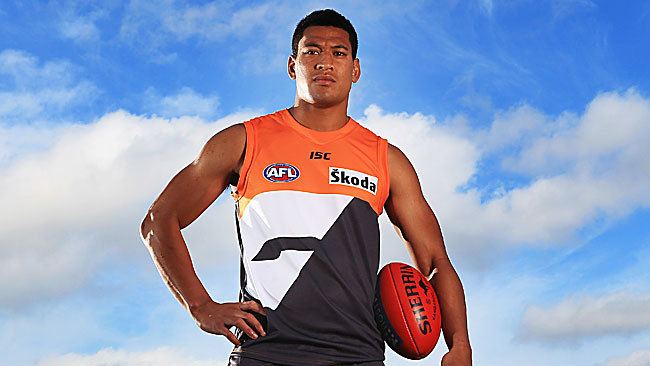
The commercial club entity itself is a 100% wholly owned subsidiary of the AFL Commission.
Early proposals
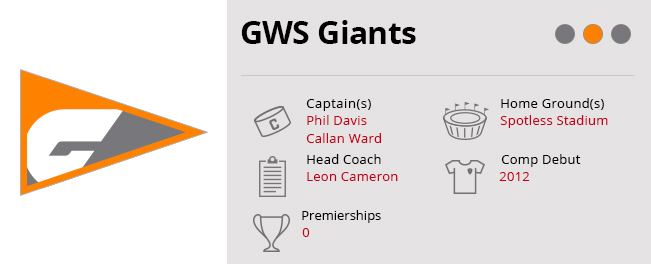
The idea of an AFL team from western Sydney originated from the AFL's plans in 1999 to make the North Melbourne Football Club Sydney's second team. Following the momentum of the relocated Swans Grand Final appearance, the AFL had backed the move for North Melbourne, a club which had then previously gained market exposure by defeating the Swans in their first re-location Grand Final appearance. However the venture was unsuccessful and after several games a season North Melbourne never managed to draw crowds of over 15,000 at the Sydney Cricket Ground before finally leaving the market and experimenting with Canberra and later the Gold Coast.

The AFL's interest in the Western Sydney market appeared to be rekindled after the Sydney Swans' second, more successful Grand Final appearance in 2005, which started grassroots interest in the game in the highly populous region. In 2006, the AFL introduced the NSW Scholarships scheme, primarily aimed at juniors in West Sydney market to foster home grown talent and produce AFL players, a region which despite its large and growing population, had produced few professional Australian Footballers. The AFL was buoyed when it gained the support of then NSW premier Morris Iemma in late 2006, and the league became a partner in the Blacktown sporting facility in Rooty Hill, New South Wales. The facility was announced as the new home base for its team out of western Sydney in 2007; it announced that it had planned to grant its 18th licence in mid to late 2008. In January 2008, the AFL officially registered the business name Western Sydney Football Club Ltd with ASIC.
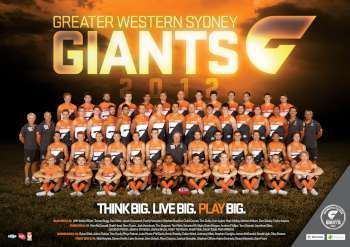
In March 2008, it was revealed by the media that the AFL had considered a radical proposal to launch an Irish-dominated team in Sydney's western suburbs, which would perform before an international audience under the "Celtic" brand name. The "Sydney Celtics" plan was first put to AFL chief executive Andrew Demetriou in early 2007 by Gaelic Players Association executive Donal O'Neill. It was said that the proposal originated at the International Rules series in Ireland in late 2006 when O'Neill put forward a plan to purchase an AFL licence in Sydney. However, the idea never materialised and the AFL has since stated that this was never a serious option.
Establishment support
In March 2008, the AFL won the support of the league's 16 club presidents to establish an eighteenth side in Western Sydney. The Western Sydney working party devising player rules and draft concessions for the second Sydney team met on 22 July 2008.
During 2008, the AFL Commission, whose agenda was to make a final decision on the Western Sydney Football Club, delayed it on multiple occasions. During the same year, in November, the AFL announced a A$100 million venture for a boutique stadium at the Sydney Showground, in the city's west.
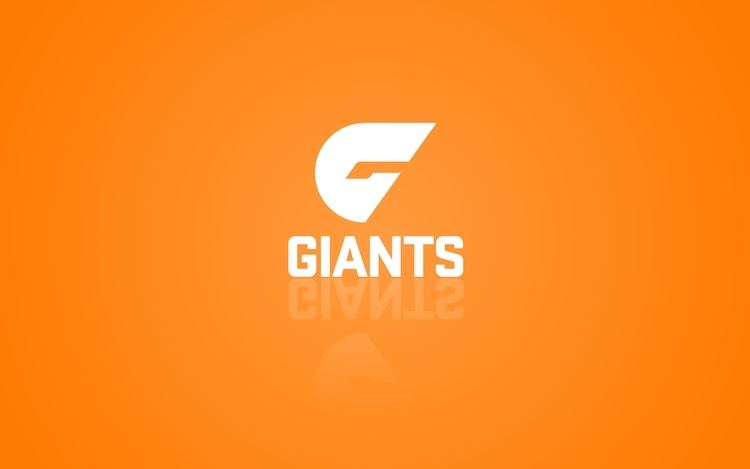
After a third meeting in Sydney in November, the AFL cited the Economic crisis of 2008 as being a key factor in the delays. While the AFL reiterated its stance on the Western Sydney licence, the commission admitted that the delay in the decision was due to financial remodeling of the bid in response to the crisis, and conceded that the debut of the team in the AFL may eventuate one or more seasons later than initially suggested. The expansion licence drew increasing media skepticism and public criticism, particularly in the light of a poor finals attendance in Sydney, declining Sydney Swans attendances and memberships, the economic crisis and the Tasmanian AFL Bid which had gained significant momentum and public support during 2008. An Australian Senate enquiry into the Tasmanian AFL Bid concluded that Sydney had "insurmountable cultural barriers" to the establishment of a second AFL team.
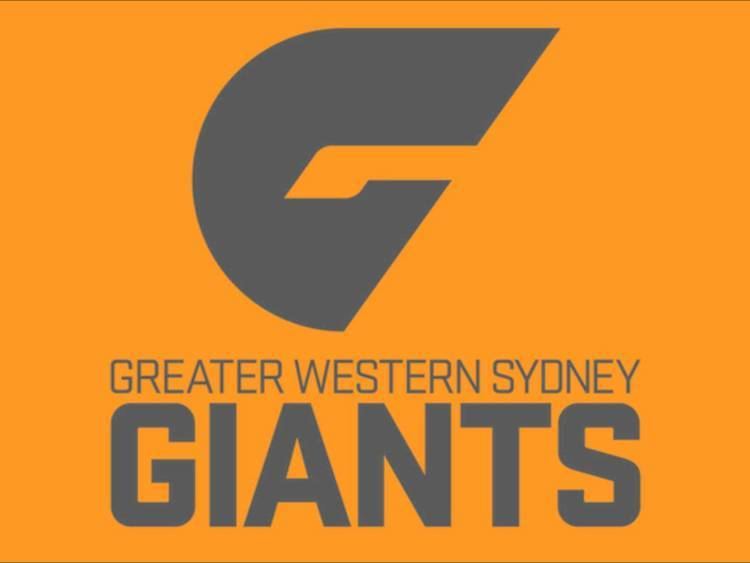
In May 2009, AIS/AFL Academy coach Alan McConnell was appointed as the club's high performance manager. McConnell was the first full-time appointment for GWS and his new role commenced on 1 July 2009. Kevin Sheedy was appointed inaugural coach in November 2009, signing a three-year contract. His role commenced on 2 February 2010. His first senior assistant coach was former premiership coach of Port Adelaide, Mark Williams. Williams left the role at the conclusion of 2012, in order to become a development coach at the Richmond Tigers.
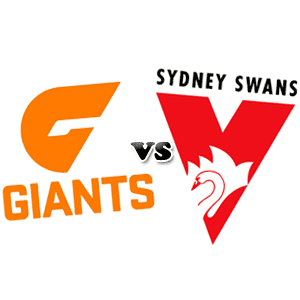
In November 2010 Skoda Australia was announced as the team's first major sponsor, signing a three-year contract which included naming rights to the team's home ground at the Sydney Showground. SpotJobs became a sponsor in March 2015. They will feature on the back of the Giants’ playing guernseys for home matches in Sydney and Canberra and on the front of the guernseys for all the team’s away games.
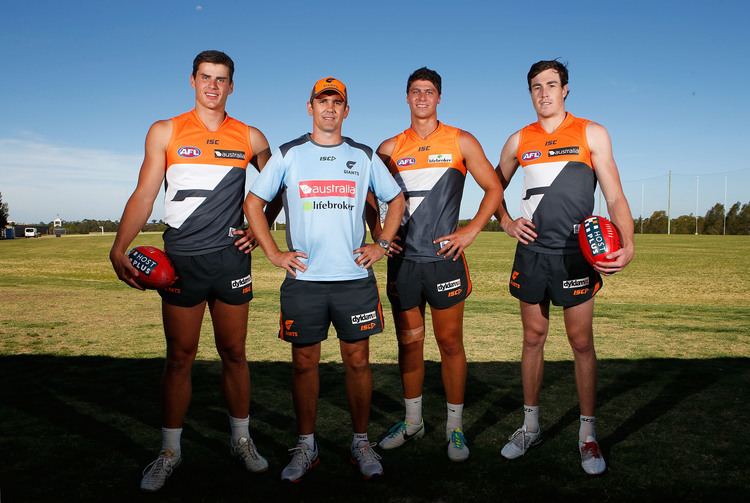
On 4 October 2012, Greater Western Sydney confirmed Leon Cameron as its new senior assistant coach for next year.
Player recruitment

Greater Western Sydney were provided with similar recruitment entitlements to the Gold Coast who had entered the AFL the year before the Giants. Key differences included that their access to an uncontracted player from each other AFL club was able to be acted on in either 2011 or 2012. The club was also allocated the ability to trade up to four selections in a "mini-draft" of players born between January and April 1994, that would otherwise not be eligible to be drafted until the 2012 AFL Draft. They also were given the first selection in each round of the 2011 AFL Draft as well as selections 2, 3, 5, 7, 9, 11, 13 and 15 in the first round of the draft.
The 2011 Trade Week saw the Giants take part in nine trades, involving two selections in the mini-draft as well trading away players who had previously nominated for the draft in return for additional early draft selections in the 2011 AFL Draft, that resulted in them holding the first five draft selections and 11 of the first 14.
During the 2011 season, there was much speculation about which uncontracted players would sign with the Giants. In August 2011, Adelaide defender Phil Davis became the first player to announce that he would sign with the new club. During 2011, four more AFL listed players announced they would be playing for the Giants in 2012 - Bulldogs midfielders Callan Ward and Sam Reid, Fremantle midfielder Rhys Palmer and Melbourne midfielder Tom Scully.
Former Melbourne Captain James McDonald, Brisbane veteran Luke Power and Port Adelaide ruckman Dean Brogan and midfielder Chad Cornes came out of retirement to play for the Giants in 2012. McDonald and Power took on roles as playing Assistant Coaches.
Greater Western Sydney also recruited Israel Folau, a former rugby league player, from the Brisbane Broncos.
2012: Debut season
Before entering the AFL, the club played in the TAC Cup in 2010 and North East Australian Football League in 2011, as well as the 2011 and 2012 AFL pre-season tournaments, and the 2011 Foxtel Cup.
The club played its first game in the Australian Football League on 24 March 2012 at ANZ Stadium in the inaugural Sydney Derby against the Sydney Swans which they lost by 63 points. On 12 May 2012 the club recorded its first win, defeating the Gold Coast Suns in a Round 7 match by 13.16 (94) to 9.13 (67). The only other victory of the team’s inaugural season was a 34-point win over Port Adelaide.
The Giants were to have numerous big losses, including five by over 100 points, beating the previous record of four set by Fitzroy in their final season, the Brisbane Bears in 1991, St Kilda in 1985 and Footscray in 1982. They lost four other games by over eighty points and finished with a percentage of 46.17, the lowest by any club since St Kilda, in 1955, had a percentage of 45.4 and, before that, Melbourne in 1919 with 43.0.
2013: Second season
In their second season, Greater Western Sydney fared even worse than in their debut season. The Giants lost their first seventeen games, an ignominy suffered previously by Fremantle in 2001, St. Kilda in 1910 and seven teams who finished with an 0–18 record. The most recent of these VFL/AFL teams losing all eighteen games was Fitzroy in 1964. Greater Western Sydney’s combined percentage for their first two seasons was indeed the lowest by any club since St. Kilda in 1901 and 1902. Furthermore, the Giants again lost five games by 100 points or more, repeating an ignominy from the debut season.
In Round 19, they avoided becoming the fourteenth club in VFL and AFL history to finish a season winless, winning their solitary game for the season against Melbourne to snap a 21-game losing streak. Leading into the final round of the home and away season, Jeremy Cameron kicked 62 goals this season and was equal third in the race for the Coleman Medal, two goals behind leader Jarryd Roughead.
At the end of the season, coach Kevin Sheedy stood aside for Leon Cameron, who had been assistant to Sheedy in 2013. On Thursday 19 December 2013, it was announced that Sheedy had been appointed to the club’s board. Club Chairman, Tony Shepherd, highlighted Sheedy's importance when he said, "In many ways Kevin Sheedy is the father of the Giants. He’s been here from the start and has helped build the Giants."
2014: Third season
Greater Western Sydney started their third season impressively winning two of their first three games, including beating their much-fancied cross-town rivals, the Sydney Swans 15.9 99 to 9.13 67 in their first round encounter at Spotless Stadium. On 13 May 2014, Greater Western Sydney midfielder Toby Greene was charged with a number of offences including assault with a dangerous weapon and intentionally causing serious injury over an alleged assault in a Melbourne licensed venue the previous night.
2015: Fourth season
Before the start of the 2015 AFL Season, the Giants managed to sign Ryan Griffen in addition to re-signing Jeremy Cameron. The club overall had a fairly successful season, finishing 11th with 11 Wins and 11 Losses, with premier Hawthorn one of their victories.
2016: Fifth season
The Giants' fifth season was their best yet, as they recorded their first positive win-loss ratio (16 wins, 6 losses), qualified for their first finals series and finished 4th out of 18 teams on the ladder.
A major highlight of the Giants' 2016 season was their 75-point win over three-time reigning premiers Hawthorn in round 6. Although they had beaten the Hawks by ten points in 2015, and went into the rematch as favourites, a margin of this size was unexpected. They also recorded their largest average home crowd in a season so far (12,333), and new recruit Steve Johnson kicked 43 goals in his first year at the Giants. The Giants finished fourth on the ladder after round 23, which meant they secured a double chance for the upcoming finals series. With cross-town rivals the Sydney Swans finishing as minor premiers, the mechanics of the AFL finals system meant that the Giants would play their first final in their five-year history against the Swans in Sydney.
In their first final, the Swans hosted the Giants at Stadium Australia (ANZ Stadium), with 60,222 spectators attending the match. This was the largest ever crowd for a match involving the club. The Giants only fielded six players who had previously played an AFL final, conversely, the Swans had six players who were making their finals debut. After a close first half, forward Jeremy Cameron kicked three goals in a five-minute period during the third quarter, as the Giants won by 36 points. The win was marred by an incident involving Steve Johnson, in which he collided with Swan Josh Kennedy and was subsequently suspended for one match; this meant he missed the preliminary final.
Two weeks later, in the preliminary final, the Giants faced the Western Bulldogs at Spotless Stadium, competing for a place in the 2016 AFL Grand Final in only their fifth year. In a close affair, both physically and on the scoreboard, the Bulldogs were attempting to make their first Grand Final in 55 years, while the Giants were looking to capitalise on their recent strong form. The Bulldogs led for most of the first half and went into half-time with a nine-point lead. In the third quarter, the Giants kicked three goals to lead by 11 points, but by three-quarter-time their lead had been reduced to one point. Early in the fourth quarter, the Giants kicked two quick goals to lead by 14 points, but the Bulldogs would kick two goals in response to take the lead, and, after scores were level with five minutes of game time remaining, a goal from Jack Macrae saw the Bulldogs win the match by six points. After the match, coach Leon Cameron said that the pre-finals bye did not have any effect on the club's performance.
Club symbols
On 16 November 2010, Greater Western Sydney announced their club guernseys and their nickname of the "Giants".
The team colours are orange, charcoal and white, with the club unveiling two prospective home jumpers for fans to be decided on for the inaugural 2012 season. One was orange with a large, stylised charcoal "G" in the centre and charcoal side panels on the sides, with the other featuring an orange yoke in the top half and a white "G" wrapped around charcoal colours in the bottom half. The colour of the team's shorts is charcoal and their socks are orange with charcoal fold-downs. During the 2011 season a clash guernsey was unveiled. The jumper has a light grey background with a charcoal rendition of the home jumper's G on the chest. This was altered in the 2012 season for a white jumper with charcoal collar and cuffs, charcoal "G" symbol in the centre and orange and charcoal stylised shoulder pads.
The clash guernsey changed in 2014, to a white top with a G that was slightly smaller than the home jumper. Included on the guernsey was also a large diagonal section of charcoal from the players left cuff down towards the centre of the bottom hem. This is repeated on the back, with the orange "G" being replaced with an orange line next to the charcoal section. The guernsey featured charcoal cuffs, numbers and collar.
The team motto is Think Big. Live Big. Play Big. Their mascot G-Man was unveiled on 18 February 2012 before the team took the ground for their first NAB Cup match of 2012.
The team song There's A Big Big Sound was first unveiled to the foundation members and 2012 members on 16 February 2012 via a phone call, the following day the team song was released to the public. The song was written and produced by award-winning Australian artist Harry Angus of Australian band The Cat Empire.
Notable supporters
Facilities
The Giants' training ground is located at Sydney Olympic Park, and was named Tom Wills Oval in 2013 in honour of Australian football pioneer Tom Wills, who was born in New South Wales and has family connections to Western Sydney.
Canberra
The Giants are expected to play four games a year at Manuka Oval (three regular season, one preseason) for the first 10 years after signing a deal with the ACT Government worth $23 million. A Canberra logo will be incorporated on its guernsey, with a separate Canberra guernsey being used for games at Manuka. The Giants also played in a special guernsey as part of the centenary of Canberra celebrations, stating that the team is "part of the Canberra community". GWS-ACT Academy is also intended to be created, with the territory also gaining representation on the club's board.
Current squad
The inaugural co-captains of the club were Phil Davis, Luke Power and Callan Ward. Both Davis and Ward were retained as captains in 2013, whilst Tom Scully was added to the leadership group as a vice-captain.
Match records
AFL Women's team
In April 2016, the Giants launched a bid to enter a team in the inaugural AFL Women's season in 2017. The club had previously partnered with the local Auburn Giants Football Club and run a female Academy program. They were announced as a founding club in June, receiving one of eight licenses awarded at this time.
Former AFL NSW/ACT Female Football High Performance coach Tim Schmidt was announced as the team's inaugural head coach in July 2016. Days later the club announced its first two players, marquee signings Renee Forth and Emma Swanson. As a result of the NSW/ACT talent pool's size and depth, the Giants were granted five priority signings prior to the draft, the most of any club in the league. Prior to the draft, the club had recruited no NSW/ACT players, instead drawing three from Western Australia, three from Victoria and one more from South Australia.
In September the Giants won the first selection in the inaugural draft via lottery, and selected Sydney University player Nicola Barr.
The team will be sponsored by Harvey Norman, FlexiGroup and Sydney Airport in its inaugural season.
